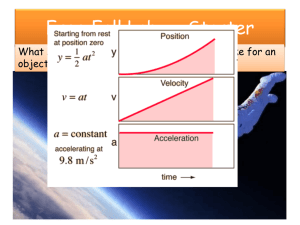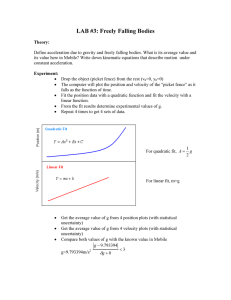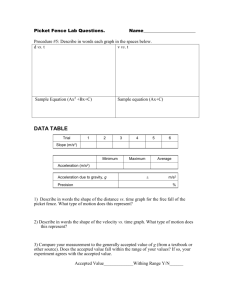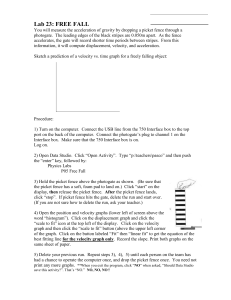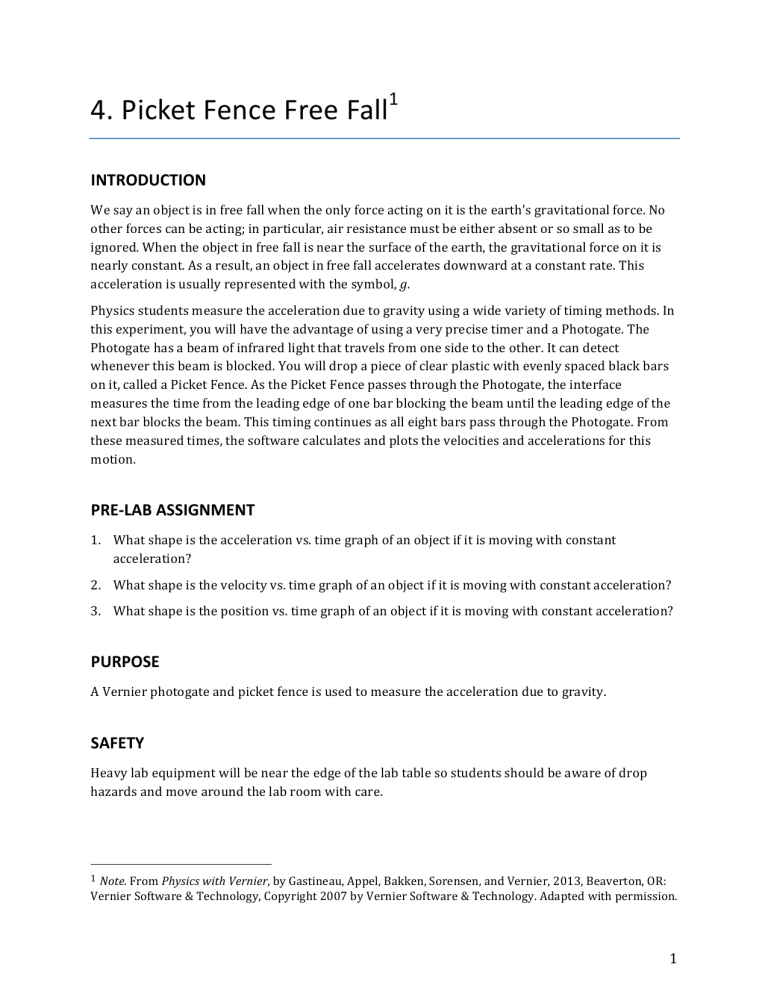
4.
Picket Fence Free Fall
1
INTRODUCTION
We say an object is in free fall when the only force acting on it is the earth’s gravitational force. No other forces can be acting; in particular, air resistance must be either absent or so small as to be ignored. When the object in free fall is near the surface of the earth, the gravitational force on it is nearly constant. As a result, an object in free fall accelerates downward at a constant rate. This acceleration is usually represented with the symbol, g .
Physics students measure the acceleration due to gravity using a wide variety of timing methods. In this experiment, you will have the advantage of using a very precise timer and a Photogate. The
Photogate has a beam of infrared light that travels from one side to the other. It can detect whenever this beam is blocked. You will drop a piece of clear plastic with evenly spaced black bars on it, called a Picket Fence. As the Picket Fence passes through the Photogate, the interface measures the time from the leading edge of one bar blocking the beam until the leading edge of the next bar blocks the beam. This timing continues as all eight bars pass through the Photogate. From these measured times, the software calculates and plots the velocities and accelerations for this motion.
PRE-LAB ASSIGNMENT
1.
What shape is the acceleration vs. time graph of an object if it is moving with constant acceleration?
2.
What shape is the velocity vs. time graph of an object if it is moving with constant acceleration?
3.
What shape is the position vs. time graph of an object if it is moving with constant acceleration?
PURPOSE
A Vernier photogate and picket fence is used to measure the acceleration due to gravity.
SAFETY
Heavy lab equipment will be near the edge of the lab table so students should be aware of drop hazards and move around the lab room with care.
1 Note.
From Physics with Vernier , by Gastineau, Appel, Bakken, Sorensen, and Vernier, 2013, Beaverton, OR:
Vernier Software & Technology, Copyright 2007 by Vernier Software & Technology. Adapted with permission.
1
MATERIALS
• LabQuest2
• Vernier photogate
• Vernier picket fence
• Threaded metal rod
• Ring stand
• Clamp
• 2-3 foam pads
PROCEDURE
1.
Install the photogate to the ring stand as shown in Figure 4.1. The threaded metal rod screws into the side of the photogate.
Figure 4.1
2.
Position the ring stand so that the photogate is hanging from the end of the table.
3.
Connect the photogate to either of the digital DIG ports in the LabQuest.
4.
Ensure that the reading on the screen is correct. Test this by waving your hand through the gate. If your reading is constantly blocked, ensure that the switch on the inside of the photogate is not blocking the emitter.
5.
Stack two or three foam pads and place them on the floor under the photogate so that the picket fence will land softly on the pads.
6.
Prepare to collect data by pinching the top of the picket fence with two fingers. Hold the picket fence straight and vertical above the gate sensor.
2
7.
Begin data collection by pressing collect button. Data is only collected once the picket fence is dropped. Let go of the picket fence from a high enough release point so as to be sure that the picket fence has left your hand completely before it falls through the photogate. The picket fence should fall as vertically as possible, without little to no sideways motion. The picket fence must also not touch the photogate.
8.
Inspect your data, if the acceleration is constant your velocity graph should be a sloped line. If there is significant noise, or any errors, in your data, repeat steps 6 and 7 until desirable results are achieved.
9.
Carefully draw a position vs. time and a velocity vs. time graph in your lab notebook. Draw these graphs only for the first trial.
10.
Look at the velocity vs. time graph in the LabQuest, if the acceleration is constant, your velocity should be an approximately straight line with near constant slope. Find the acceleration of the picket fence by fitting a linear equation to the velocity vs. time graph. Do this by selecting
Analyze->Curve Fit->Velocity->Linear Fit.
11.
The slope, m, from this fitted equation will be your experimental determination of the value of g , the acceleration due to gravity. Be sure to record this value in Table 4.1. In this experiment we are not particularly interested in b, the y-intercept, or the initial velocity.
12.
Repeat steps 6 through 11 four more times and record the acceleration values to give, in the end, five total trials. The goal of carrying out multiple trials, or runs, is to be sure you are producing reliable data.
13.
Proceed to the Analysis Questions after all of the trials have been completed.
14.
Clean up: Remove the clamp from the ring stand and unscrew the metal rod. Return the lab equipment to the cart or side tables in the same functioning shape as you found it.
Table 4.1
Trial # Gravitational Acceleration , g (m/s 2 )
3
4
1
2
5
ANALYSIS
1.
Determine the minimum, maximum, and average acceleration from the five trials. Record these statistical values in your lab notebook.
3
2.
The average value represents a best value you obtained from your trials, while the minimum and maximum values can give an indication of how much your measured values vary. When we state experimentally determined values, we normally express them in terms of capable precision or uncertainty, such as 9 .
9 ± 0 .
2 𝑚 / 𝑠 !
. Record your experimentally determined value of acceleration using the average acceleration value and an uncertainty as average acceleration ± uncertainty where the uncertainty can be approximated as uncertainty = (maximum - minimum)/2
3.
Use the accepted value for the acceleration due to gravity 9.80 m/s 2 and find the percent error between the accepted value and your measured experimental value. 𝑝𝑒𝑟𝑐𝑒𝑛𝑡 𝑒𝑟𝑟𝑜𝑟 = 𝑎𝑐𝑐𝑒𝑝𝑡𝑒𝑑 − 𝑒𝑥𝑝𝑒𝑟𝑖𝑚𝑒𝑛𝑡𝑎𝑙 𝑎𝑐𝑐 𝑒𝑝𝑡𝑒𝑑
× 100
POST-LAB QUESTIONS
1.
If you released the picket fence from a higher position, would this affect the measured acceleration of the picket fence?
2.
Will the initial velocity ( v
0
) of an object change its acceleration? For an example, if you throw ( v
0
≠ 0) the picket fence from a height and it leaves your hand completely before passing through the photogate, will the measured acceleration value of the picket fence be significantly different than just releasing ( v
0
= 0) the picket fence?
3.
What would happen to the measured acceleration of the picket fence if it was thrown upward through the photogate? Again, assume the picket fence leaves your hand completely before passing through the photogate.
4.
How would the slope of velocity vs. time graph be different if you did this lab on the moon?
‘Steeper’, or ‘Not as steep’, or ‘It would be no different’? Justify your answer.
2
CONCLUSION
• Summarize your results.
• Discuss the possible sources of error.
2 PASCO Advanced Physics, page 89
4

